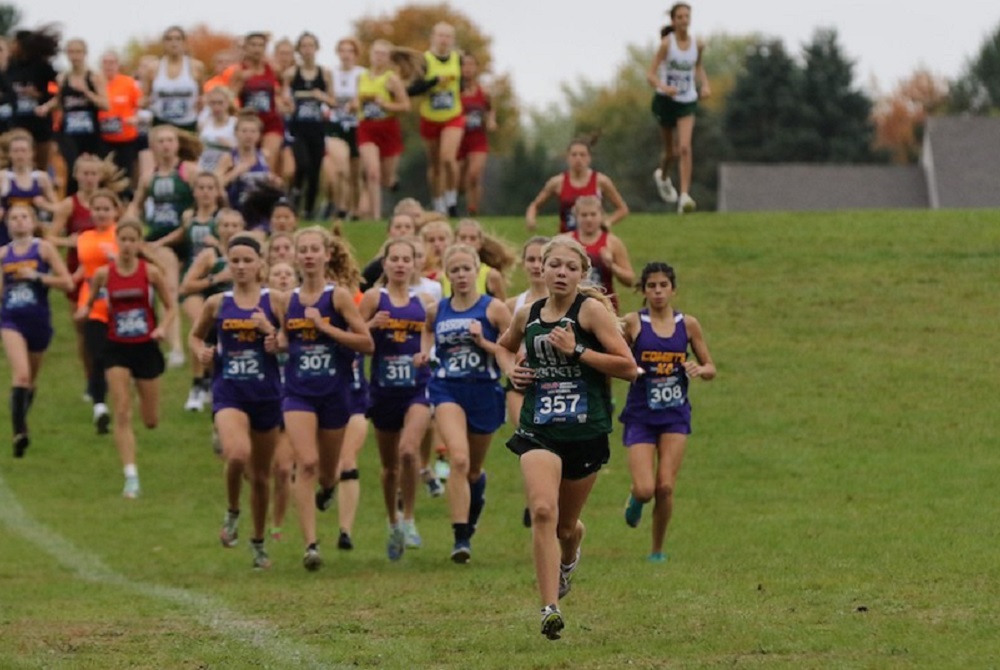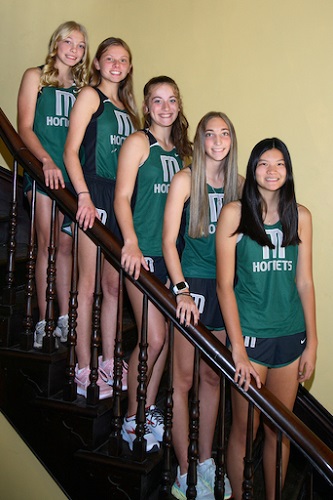
Cheerleader Support Helps Mendon Return to Cross Country Finals
By
Wes Morgan
Special for MHSAA.com
November 2, 2021
Art Stephenson’s family knows not to make any big plans in early November.

Each season of his 18-year tenure has ended the same way, with the Mendon cross country coach roaming Michigan International Speedway and motivating his runners in green.
The Mendon girls team’s appearance this weekend at the MHSAA Lower Peninsula Division 4 Finals in Brooklyn marks the seventh since Stephenson took over. Previously, the boys team made 17 consecutive trips to the championship race.
Even with fourth-seeded freshman Presley Allen leading the way in an unbelievable debut season, the Hornets were on the verge of seeing that team-qualifying streak snapped. For most of the year, Stephenson’s squad didn’t have enough runners to register team points. In fact, it took until Oct. 16 at the Sturgis Kiwanis Invitational for Mendon to put together five times for a team score.
Like most small schools, Mendon struggles yearly to fill out its athletic rosters. And considering the storied histories of the Hornets’ volleyball and football programs, getting kids to choose cross country — despite its own record of consistent success — isn’t always easy. So, numbers were low this year, and with Allen missing four of the first six meets due to COVID, a team trip to MIS didn’t appear to be in the cards.
But Allen, who had nine individual victories and a school-record time of 18:37 in a runner-up performance against top-ranked Abby VanderKooi (of Muskegon Western Michigan Christian) at the Portage Invite this fall, eventually returned to full strength. And she and teammates Amber Hostetler (senior), Lauren Schabes (junior) and Chloe Behrends (senior) spent their free time recruiting anyone who would listen.
Cheerleaders Alivia Stuart (senior) and Gracey Loker (junior) answered the call as first-time runners.
 “We didn’t have enough to score as a team for either boys or girls for most of the year,” Stephenson said. “We were wondering if we were ever going to with this girls team, to be honest with you. We had Alivia, who ran her heart out last Saturday (at Regionals), she came out, and so did Gracey Loker — they both came out and they have obviously been great additions to the team. They allowed us to get to this point where we’re going to the state meet.
“We didn’t have enough to score as a team for either boys or girls for most of the year,” Stephenson said. “We were wondering if we were ever going to with this girls team, to be honest with you. We had Alivia, who ran her heart out last Saturday (at Regionals), she came out, and so did Gracey Loker — they both came out and they have obviously been great additions to the team. They allowed us to get to this point where we’re going to the state meet.
“It is a hard thing to do and a hard thing to convince a kid to do. The least amount you’re going to do on any given day of practice is four miles. It’s a hard sell. But we do a lot of things outside of practice. We used to do more before the pandemic. We do team dinners, which is always a fun thing to do. With the smaller teams, we still have just as much fun. It’s a good thing.”
Mendon finished fourth at the Division 4 Regional at Portage Central with 92 points, trailing Kalamazoo Christian (26) and Battle Creek St. Philip (72). Allen was medalist by over a minute with a time of 19:02.09. But a 13th-place finish by Hostetler, a 23rd-place effort by Schabes, Stuart’s 34th-place run and Behrends’ 45th-place finish helped secure the Finals berth.
Allen’s rise to the top of the program’s record list required besting her cousin Kasey Culp’s time of 18:43 from 1997.
“She was cheering me on the whole time,” Allen said of Culp. “She lives in Kentucky and she was texting me and asking me … she was almost as nervous as I was.”
Having competed against most of the top-seeded runners in D4 already this season, Allen is excited to be a part of a lead pack Saturday in Brooklyn that includes VanderKooi, Buckley sophomore Aiden Harrand, Maple City Glen Lake senior Makenna Scott and Western Michigan Christian freshman Grace VanderKooi.
“It really makes me think about how they were running in each meet and what they do,” Allen said. “It has helped me know what to do when I go to state.”
“She has had a lot of success this year,” Stephenson said of Allen. “She had COVID early on in the year and we’re lucky it was early on in the year. It took her a while to get back. I think she’s back to form now and doing well. She is definitely there in that top five (at state). She is probably the most driven runner I’ve ever had. She’s amazing, and she loves to do what she’s doing — and it shows. She has a workout regimen that I defy any high schooler to do.
“Getting out clean isn’t a worry because she gets out fast. That’s always been her thing. She has only been behind a couple times this season. She’ll keep chasing if that happens. This week is going to be an awesome race because of who you have there. That’s quite a top five for a D4 Final. It is going to be a fun race to experience.”
Stephenson and Allen both agreed it will be a whole lot more fun having that experience as a team, made a whole lot sweeter after the adversity they faced in 2021.
“It doesn’t matter when we get them, as long as we get them,” Stephenson said. “Everyone is out here doing the same thing for the same cause.”
 Wes Morgan has reported for the Kalamazoo Gazette, ESPN and ESPNChicago.com, 247Sports and Blue & Gold Illustrated over the last 12 years and is the publisher of JoeInsider.com. He can be reached at [email protected] with story ideas for Berrien, Cass, St. Joseph and Branch counties.
Wes Morgan has reported for the Kalamazoo Gazette, ESPN and ESPNChicago.com, 247Sports and Blue & Gold Illustrated over the last 12 years and is the publisher of JoeInsider.com. He can be reached at [email protected] with story ideas for Berrien, Cass, St. Joseph and Branch counties.
PHOTOS (Top) Mendon’s Presley Allen leads the pack during her team’s Division 4 Regional at Portage Central. (Middle) The Hornets advanced to the Finals as a team with a third-place Regional finish. (Photos by Nicci Plummer/JoeInsider.com.)

MHSAA Vault: MIS Rose to Challenges to Host 2020 LP Finals
By
Rob Kaminski
MHSAA benchmarks editor
November 12, 2021
The “MHSAA Vault” features stories from past publications and other documents in the MHSAA Library. This issue takes a look at the MHSAA Cross Country Finals at Michigan International Speedway, which celebrated 25 years in 2020 – although it was an event that nearly didn’t happen last fall …
In 1996, the MHSAA and Michigan International Speedway began a partnership the changed the course of the Lower Peninsula Cross Country Finals – quite literally.
The land in and around the track at Brooklyn would host the Finals for all classes of runners in one place on one day, an annual festival of nearly 2,000 runners competing for the MHSAA’s top honors.
Even skeptics – and there were several among running purists who thought the course was too flat, for example – can’t deny the results.
Finals attendance nearly doubled in that first year, and crowds in excess of 10,000 have enjoyed a day of racing several times, including a record 12,153 in 2011.
Enthusiastic crowds were the norm in recent years, with 11,232 in 2017, and nearly 11,000 in 2018 (10,989) and 2019 (10,873).
In fact, attendance failed to reach at least 8,000 only twice since the move to MIS.
Of course, last year was an exception, when attendance was limited to 1,000 spectators per session due to the COVID-19 Pandemic. Fans also were restricted to the grandstands rather than following the action throughout locations on the course.
To reduce the number of runners in each race, the event was spread over two days, with each Division being run in two separate “sections” with times then combined at the end to determine team and individual champions.
While not ideal, the end result was another year of fantastic efforts at MIS – both from student-athletes and those behind the scenes.
“Even at the last hour, less than a week ahead of the Finals, we were closer to not having the Finals than we were to having them,” said MHSAA Assistant Director Cody Inglis, who coordinates the cross country postseason. “Rumors and challenges of mandated shutdowns, testing and other requirements were being discussed and caused a lot of unknowns. Even at the Regional level, we had schools, Regional courses and hosts shutting down their facilities; we had to relocate four Regionals 48 hours prior to race times. That scenario just could not happen at the Finals level where far more runners and much more travel would be involved.”
Among the many last-minute hurdles was the edict from NASCAR – which owns MIS – that all persons on site be temperature checked upon entry. That meant securing thermometers that were easy to operate in short order, along with personnel necessary to conduct the readings.
The attendance limitations certainly helped to implement the temperature screening, but brought their own issues.
“Limiting spectators was not a popular decision, but it really was the only way to have a race,” Inglis said. “We were taking direction and working with policies and protocols from the MDHHS, the Governor’s office, Lenawee County Health Department, MIS and NASCAR.”
Part of the solution was to utilize the grandstands as a “barrier” between participants and spectators. The reduced number of fans were dispersed over thousands of seats while still allowing them the chance to watch their student-athletes compete.
“It wasn’t the same, it wasn’t easy or perfect, but it was what we had to do to have a race,” Inglis said. “Separating the Finals into two days and different sections also allowed us to spread out the event and limit the number of people on site at any one time. This was a key part of the plan and worked well even though it separated races within a Division.”
The MHSAA, MIS and the cross country community never lost focus of the main goal: a culmination of the season for the student-athletes, who deserved something last year more than ever. And, more than ever, MIS once again displayed its advantage as a venue that could adapt to the fluid nature of the times to pull off the event.
“There were some thoughts of using four different sites, but as we learned during the Regionals, the climate of things was so tenuous from one area of the state to another that we couldn’t be 100-percent certain that there wouldn’t again be last-minute cancelations,” Inglis said. “MIS was wonderful to work and collaborate with, and was the best option to get it done. It was never mentioned once publicly about the possibility of not having the Finals – only how we could best do it under uncharted conditions.”
The moving parts and ever-changing scenarios created more complexity than ever in finalizing a season, but every decision was made with the complete desire to conduct the Finals as close to normal as possible.
“I firmly believe that a finish to the season, no matter the differences in race formatting and fan experience, was something everyone would have taken when the season began in August,” Inglis said.
Indeed, the finish line in Year 25 at MIS might have been the most gratifying of them all.

